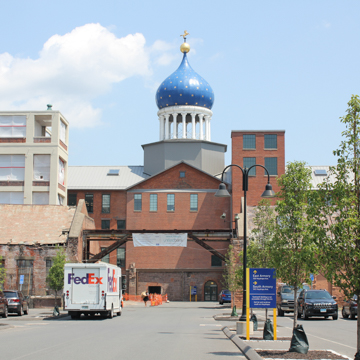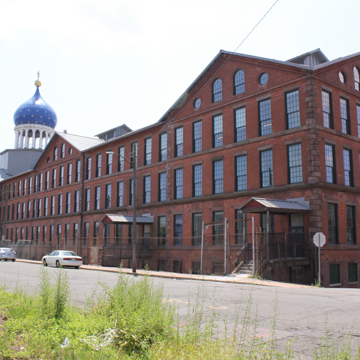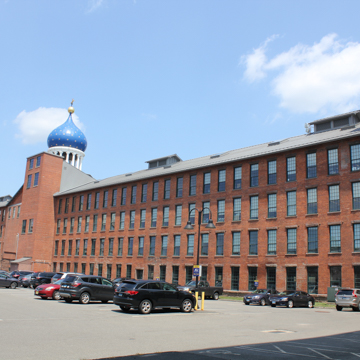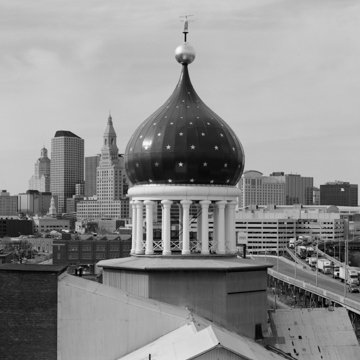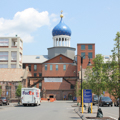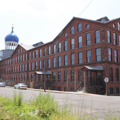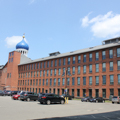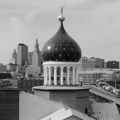Colt Armory
Colt Armory refers to the East Armory of the Colt manufacturing complex, which is a part of the 260-acre Coltsville district. This National Historic Landmark district encompasses the factory, foundries, power plants, worker housing, a church and parish hall, a farm and produce warehouse, a riverport dock and railroad depot, and, on the hill, Armsmear, Samuel Colt’s house. The crowning feature of Colt Armory is its large blue onion dome, topped by a golden colt statue that overlooks the district and the Connecticut River Valley. Colt Armory and its signature dome is a symbol of Hartford, the Colt firearm empire, and Samuel Colt himself.
Colt, born in 1814, had a troubled youth and was sent to work on a ship. It was on this trip, according to his account of his origins, that young Sam observed the churning of the ship’s paddle and was inspired to whittle the first wooden model of the Colt revolver. For the early years of his adult life, Colt was an entrepreneur, trying his hand at selling a variety of inventions. Along the way, he made enemies of collaborators and debtors, but through excellent salesmanship and luck was able to secure government contracts, favorable press, and investments. His failures taught him the importance of marketing, a flexible and innovative manufacturing process, and a good team. Colt’s first factory was built in 1848 on undeveloped land of the Hartford South Meadows floodplain of the Connecticut River Valley. The following year he developed the .31-caliber pocket revolver, which became the most successful handgun sold by Colt or any of his competitors during his lifetime. In 1849, Colt also made his first international sales trip to Europe and Turkey, and hired Elisha King Root as superintendent and technologist-in-residence of the Colt Armory. With Root in Hartford running operations, Colt was able to devote his time to marketing. The company grew astronomically—20,000 pistols were produced in 1851, a number which rose to 136,579 at the height of the Civil War in 1863.
During a trip to Russia in 1854, Colt gave a presentation at the court of Czar Nicholas I, and following his return to Hartford in 1855 he hired Hartford architect Octavius Jordan to draw up plans for a new and larger armory. Colt, despite his lack of expertise, outlined many of the design features of the building. Impressed by many features of Russian architecture, he encouraged Jordan to sketch an onion dome for the main armory building. Colt’s nephew, Henry A. G. Pomery, was hired to supervise the engineering of the building. The three armory buildings and attendant foundries, Buildings 8 and 10, formed a double-H, with the East Armory forming the arm parallel and adjacent to the Connecticut River. The East Armory, with its iconic blue onion dome, was the first building completed.
Samuel Colt died in 1862. The structure that stands today is mostly an 1867 reconstruction, an effort spearheaded by Elizabeth Colt following a disastrous fire in 1864. The reconstruction is similar in design to the original building. Three-and-a-half stories of brick are accented with brownstone. The primary mass, parallel to the river, has a gable roof that is crossed by five gables, the center of which projects to form an entrance vestibule. On the top story, under each gable, two arched windows are flanked by round windows; the remaining stories feature large, rectangular windows. The ground level has been altered, and what was previously a basement is now exposed, with bridges added to permit crossing. At the center, below the dome, several steps lead up to an arched doorway trimmed in brownstone. The blue onion dome, perched on a circle of white columns, is studded with gold stars and topped by a figure of a rampant colt on a gold sphere, the company insignia, which represents the domination of Colt over the world. (The current dome is a fiberglass replica of the original wooden structure). Each floor of the East Armory contains a 500 × 60–foot room, with rows of 60 cast-iron columns originally supporting line-shafting, powered by a 250-horsepower steam engine. When Mark Twain visited the East Armory in 1868, he noted that “on every floor is a dense wilderness of strange iron machines that stretches away into remote distances . . . all the imaginable and unimaginable forms of mechanism.”
The architecture of Colt Armory has rational proportions, utilitarian elegance, and cosmopolitan inflection. Its elegance contrasts with the violent legacy of the firearms manufactured here, as Colt’s revolver became an icon of the triumph of the American frontiersmen over Indigenous people in the Americas. Images of the battles that figured in this history were engraved onto the cylinders of Colt revolvers, serving as advertisements for the firearms and highlighting the complicated legacy of Manifest Destiny.
Like many post-industrial American cities in the twentieth century, Hartford has faced periods of downturn. The East Armory has been redeveloped, and now accommodates a high school and commercial businesses, but is still under renovation, with much of the north side and top floor unused. The South Armory now hosts a brewery, coffee shop, and offices, while the North Armory has been renovated into apartments. The National Park Service is pursuing a land transfer for Buildings 8 and 10 and has plans to open a visitor center and to operate Coltsville as a “partnership park,” collaborating with public, private, and nonprofit organizations to permit further redevelopment and conservation of the area. There is a richness of architectural and historical significance at Coltsville, and efforts to preserve, interpret, and make public the stories of Colt Armory will be a valuable historical resource for future generations.
References
Cooper, Carolyn C., and Robert B. Gordon. "‘Sam and Elizabeth: Legend and Legacy of Colt's Empire’: An Exhibition Review." Winterthur Portfolio 32, no. 4 (1997): 275–84. http://www.jstor.org/stable/1215194.
Davis Brody Bond Architects. Colt Armory: Coltsville National Historical Park—Space Planning and Programming Study. Hartford, CT: National Park Service/Coltsville National Historical Park, October 26, 2018.
Hosley, William. Colt: Making of an American Legend. Amherst: University of Massachusetts Press, 1996.
Long, Andrew (Park Ranger, Coltsville), interview by author, Coltsville, Hartford, CT, 29 July 2019.
Schroer, Blanche Higgins, "Colt Historic District," Hartford County, Connecticut. National Historic Landmark Nomination Form, 1977. National Park Service, U.S. Department of the Interior, Washington, D.C.
Writing Credits
If SAH Archipedia has been useful to you, please consider supporting it.
SAH Archipedia tells the story of the United States through its buildings, landscapes, and cities. This freely available resource empowers the public with authoritative knowledge that deepens their understanding and appreciation of the built environment. But the Society of Architectural Historians, which created SAH Archipedia with University of Virginia Press, needs your support to maintain the high-caliber research, writing, photography, cartography, editing, design, and programming that make SAH Archipedia a trusted online resource available to all who value the history of place, heritage tourism, and learning.






